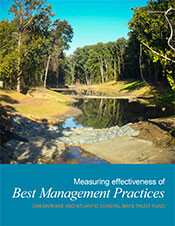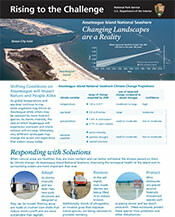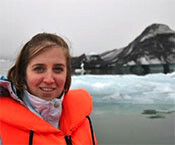Measuring effectiveness of Best Management Practices
 The Chesapeake and Atlantic Coastal Bays Trust Fund was created in 2007 in an effort to reduce nutrient and sediment pollution to these bays. The Trust Fund has focused its financial resources on the implementation of effective non-point source pollution control projects using best management practices (BMPs) in high priority watersheds. Examples of projects supported by the Trust Fund include stream channel restorations, stormwater retrofits, and cover crops. Evaluating BMP effectiveness is necessary for demonstrating whether projects actually reduce pollutant yields. The current monitoring strategy indicates that BMPs implemented in Trust Fund projects must demonstrate a water quality response within three years of completion. This document provides an overview of the challenges facing Chesapeake and Atlantic Coastal Bays and provides guidance to potential and current Trust Fund recipients in determining suitable approaches for measuring BMP effectiveness.
The Chesapeake and Atlantic Coastal Bays Trust Fund was created in 2007 in an effort to reduce nutrient and sediment pollution to these bays. The Trust Fund has focused its financial resources on the implementation of effective non-point source pollution control projects using best management practices (BMPs) in high priority watersheds. Examples of projects supported by the Trust Fund include stream channel restorations, stormwater retrofits, and cover crops. Evaluating BMP effectiveness is necessary for demonstrating whether projects actually reduce pollutant yields. The current monitoring strategy indicates that BMPs implemented in Trust Fund projects must demonstrate a water quality response within three years of completion. This document provides an overview of the challenges facing Chesapeake and Atlantic Coastal Bays and provides guidance to potential and current Trust Fund recipients in determining suitable approaches for measuring BMP effectiveness.
Rising to the Challenge: A National Park Service brochure
 As global temperatures and sea levels continue to rise, some organisms may thrive on Assateague Island while others may be replaced by more tolerant species. As storms intensify, the rate at which this Mid-Atlantic barrier island will experience overwash and rollover will increase. Ultimately, very different landscapes may change the access and experience that visitors enjoy today at Assateague Island National Seashore. While coastal areas are particularly vulnerable to sea-level rise and extreme weather events, inland areas are also being affected. This National Park Service site bulletin features the pro-active steps of adaptation, restoration, and protection being taken by the National Seashore, and also provides empowering suggestions for everyone to prepare for and cope with the effects of climate change.
As global temperatures and sea levels continue to rise, some organisms may thrive on Assateague Island while others may be replaced by more tolerant species. As storms intensify, the rate at which this Mid-Atlantic barrier island will experience overwash and rollover will increase. Ultimately, very different landscapes may change the access and experience that visitors enjoy today at Assateague Island National Seashore. While coastal areas are particularly vulnerable to sea-level rise and extreme weather events, inland areas are also being affected. This National Park Service site bulletin features the pro-active steps of adaptation, restoration, and protection being taken by the National Seashore, and also provides empowering suggestions for everyone to prepare for and cope with the effects of climate change.
Marine Protected Areas: Guiding principles and benefits
 Marine Protected Areas (MPAs) are slices of the sea and coastline set aside because of their ecological importance. Creating an MPA requires a holistic approach that includes and integrates ecological, biological, social, and economic considerations. This approach cannot be successful without proper legislation, a functional institutional framework, financial resources, and active engagement of stakeholders. The WWF MedPAN South Project is a four-year collaborative project aimed at improving the management effectiveness of MPAs in the south and east of the Mediterranean and supporting the creation of new ones. A partnership with IAN was formed to create two documents which summarize the lessons learned from case studies in four countries with MPAs—Algeria, Croatia, Tunisia, and Turkey—currently in various stages of development and provide key actions needed to achieve success.
Marine Protected Areas (MPAs) are slices of the sea and coastline set aside because of their ecological importance. Creating an MPA requires a holistic approach that includes and integrates ecological, biological, social, and economic considerations. This approach cannot be successful without proper legislation, a functional institutional framework, financial resources, and active engagement of stakeholders. The WWF MedPAN South Project is a four-year collaborative project aimed at improving the management effectiveness of MPAs in the south and east of the Mediterranean and supporting the creation of new ones. A partnership with IAN was formed to create two documents which summarize the lessons learned from case studies in four countries with MPAs—Algeria, Croatia, Tunisia, and Turkey—currently in various stages of development and provide key actions needed to achieve success.
Welcome to Sarah Lane
 Sarah joins IAN as part of the UMCES and MD DNR partnership. She is providing technical support for DNR's coastal non-point source pollution reduction programs. Sarah will manage Maryland's Innovative Technology Fund, incorporate climate adaptation considerations into natural filter implementation, and integrate the latest research information to improve the state's coastal non-point source programs and policies. Prior to joining UMCES, she worked with UMD College of Agriculture, and has also worked for the Mid-Atlantic Water Program, Chesapeake Bay Program Office, and Center for Watershed Protection. Sarah received a BS in Geography and Environmental Systems from the University of Maryland Baltimore County, and a MS in Environmental Sciences and Policy from Johns Hopkins University. When she's not estimating best management practice efficiencies, Sarah is training for triathlons, playing soccer, tasting a new hot sauce, or traveling with her husband Ian.
Sarah joins IAN as part of the UMCES and MD DNR partnership. She is providing technical support for DNR's coastal non-point source pollution reduction programs. Sarah will manage Maryland's Innovative Technology Fund, incorporate climate adaptation considerations into natural filter implementation, and integrate the latest research information to improve the state's coastal non-point source programs and policies. Prior to joining UMCES, she worked with UMD College of Agriculture, and has also worked for the Mid-Atlantic Water Program, Chesapeake Bay Program Office, and Center for Watershed Protection. Sarah received a BS in Geography and Environmental Systems from the University of Maryland Baltimore County, and a MS in Environmental Sciences and Policy from Johns Hopkins University. When she's not estimating best management practice efficiencies, Sarah is training for triathlons, playing soccer, tasting a new hot sauce, or traveling with her husband Ian.

